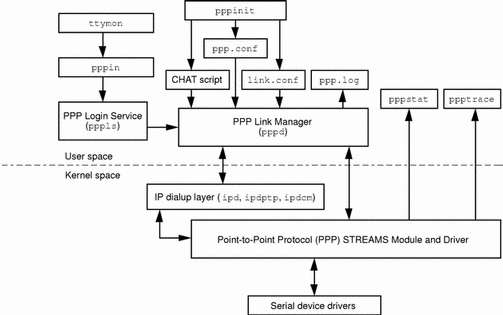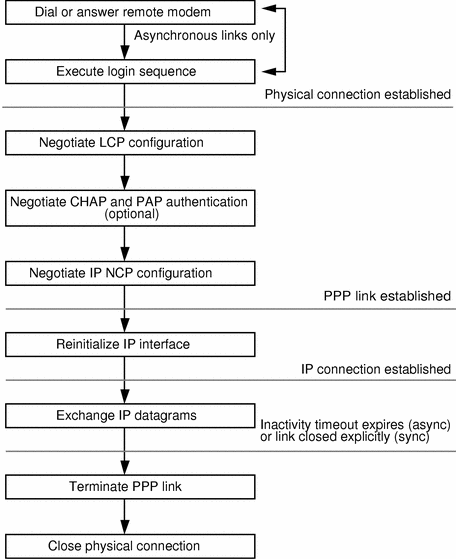Solstice PPP Product Architecture
The primary components of Solstice PPP are shown in Figure 1-7 and are described in the following sections.
Figure 1-7 Solstice PPP Product Architecture

Point-to-Point Protocol (PPP) STREAMS Module
The PPP STREAMS module is a standard implementation of the Point-to-Point Protocol described by RFC 1661. It establishes and configures data-link level connections across serial point-to-point links, and encapsulates IP datagrams for transmission as PPP frames.
IP Dialup Layer
The IP dialup layer represents the boundary between Solstice PPP and the Solaris TCP/IP protocol suite. It includes a connection manager (ipdcm), which maintains and monitors the logical IP interfaces used by the IP layer to transmit datagrams across a PPP link, and the IP interfaces themselves. There are two types of IP interface associated with Solstice PPP:
See "Establishing IP over PPP" for a detailed description of these interfaces.
PPP Link Manager
The PPP link manager (pppd) controls all the communication links established using Solstice PPP. It reads the information in the Solstice PPP configuration files and configures the IP dialup layer and the PPP STREAMS module.
PPP Login Service
The PPP login service (pppls) is used to accept incoming connections from remote users. It relies on the standard UNIX login to validate the user name and password, and informs the PPP link manager of the existence of a valid PPP connection when the user is accepted.
Before a machine running Solstice PPP can accept incoming calls, the system administrator must create a user account for each remote user. This account must contain the user name and password, and must call /usr/sbin/pppls as the default login shell.
See "Adding User Accounts for Incoming Connections" for a detailed description of how to create user accounts for the PPP login service.
PPP Diagnostic Utilities (ppptrace and pppstat)
Solstice PPP includes two diagnostic utilities that display information recovered from the PPP STREAMS module. The PPP trace utility /usr/bin/ppptrace displays PPP frame information, and the statistics collection utility /usr/bin/pppstat displays a cumulative record of the number and type of PPP frames sent and received since Solstice PPP was started.
PPP Initialization Script (pppinit)
The PPP initialization script, /usr/bin/pppinit, is used to create a basic network configuration. Use pppinit to configure Solstice PPP for the first time, and then modify the configuration files to create more complex PPP networks.
PPP Configuration Files (ppp.conf and link.conf)
Configuration information for Solstice PPP is contained in two configuration files. These files are created with basic configuration information using the PPP initialization script (pppinit). They may be modified later to add details of more complex configurations.
The file /etc/opt/SUNWconn/ppp/ppp.conf describes the synchronous and asynchronous paths used for IP connections over PPP. The file /etc/opt/SUNWconn/ppp/link.conf defines the various serial devices available for establishing PPP links, and creates a mapping between these devices and the remote hosts for outgoing connections.
See Chapter 4, Editing the Configuration Filesfor a detailed description of these files.
PPP CHAT (or Connect) Scripts
By default, the CHAT (or connect) scripts are located in the directory /etc/opt/SUNWconn/ppp/script. CHAT scripts contain information that defines the login dialog used to initiate asynchronous connections to remote hosts, including the login id and login password sent by the local host. You must create a unique CHAT script for each remote host to which connections will be initiated.
Some of the information contained in the CHAT script is dependent on the operating system running on the remote host. The PPP initialization script (pppinit) can be used to create CHAT scripts to initiate connections to hosts running a SolarisTM environment.
PPP Log File (ppp.log)
The status and error messages generated by the PPP link manager are logged in the file /var/adm/log/ppp.log. See "Status and Error Messages" for a detailed description of the messages that appear in this file.
Figure 1-8 IP Connections over Synchronous and Asynchronous Links

- © 2010, Oracle Corporation and/or its affiliates
